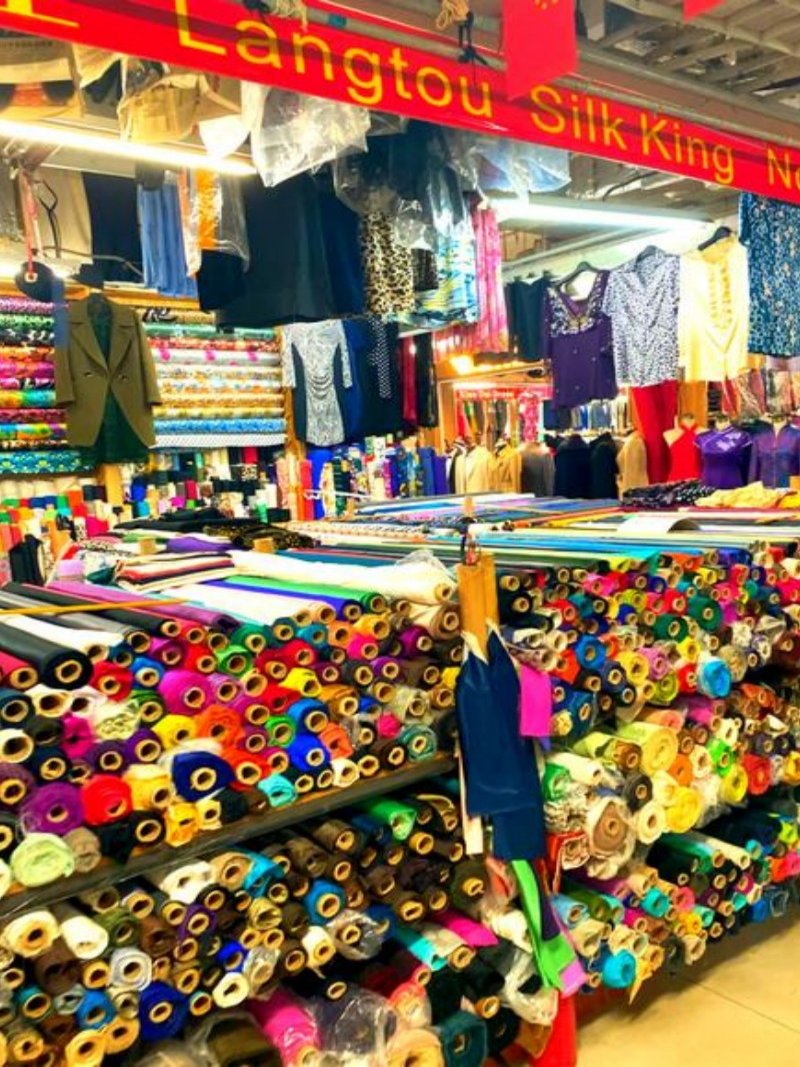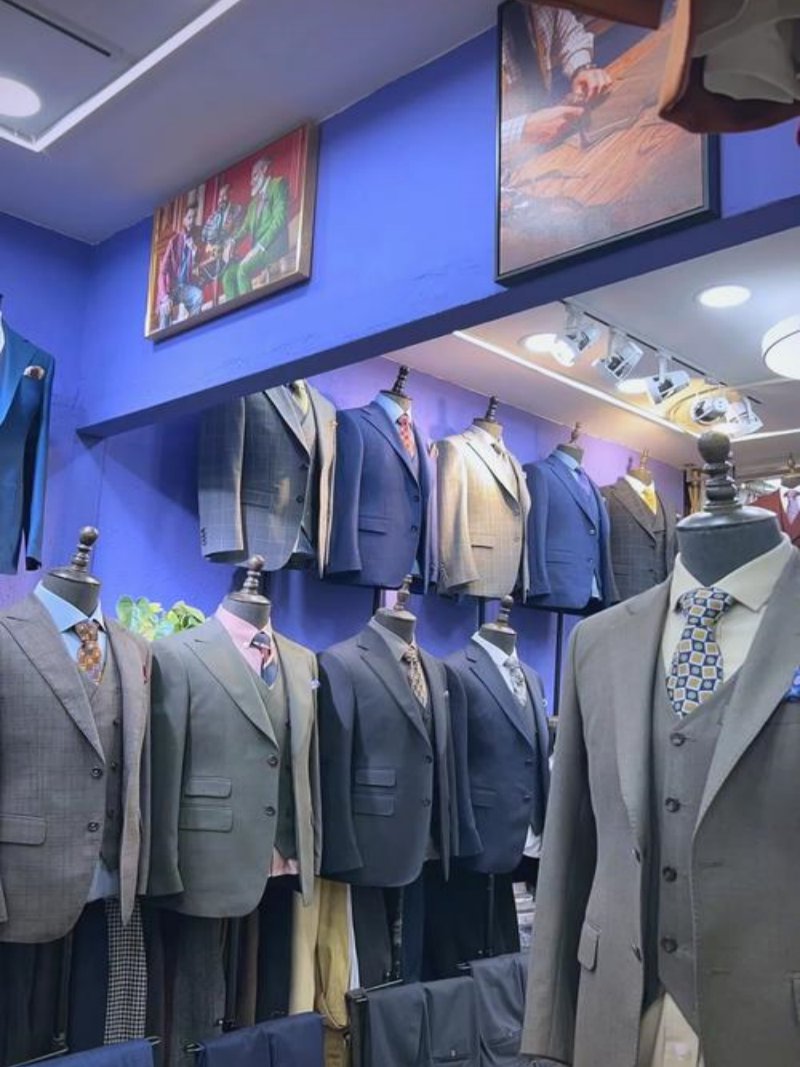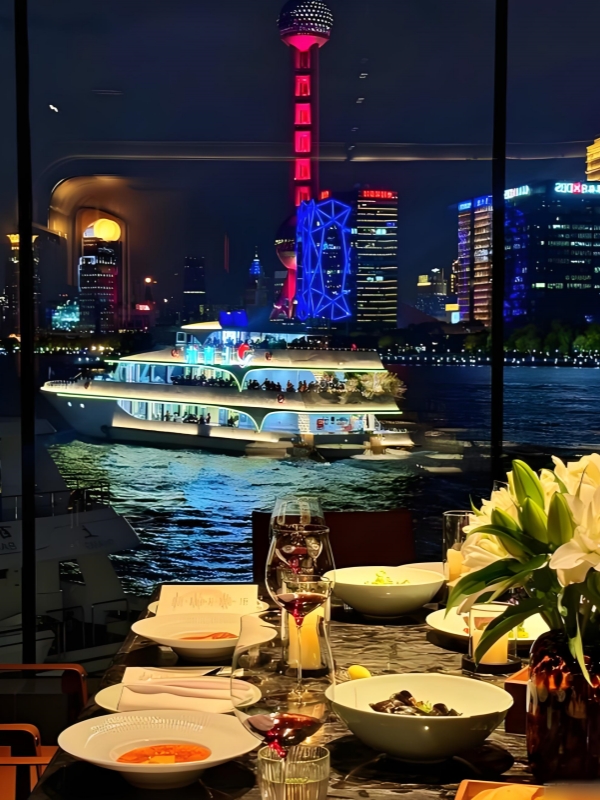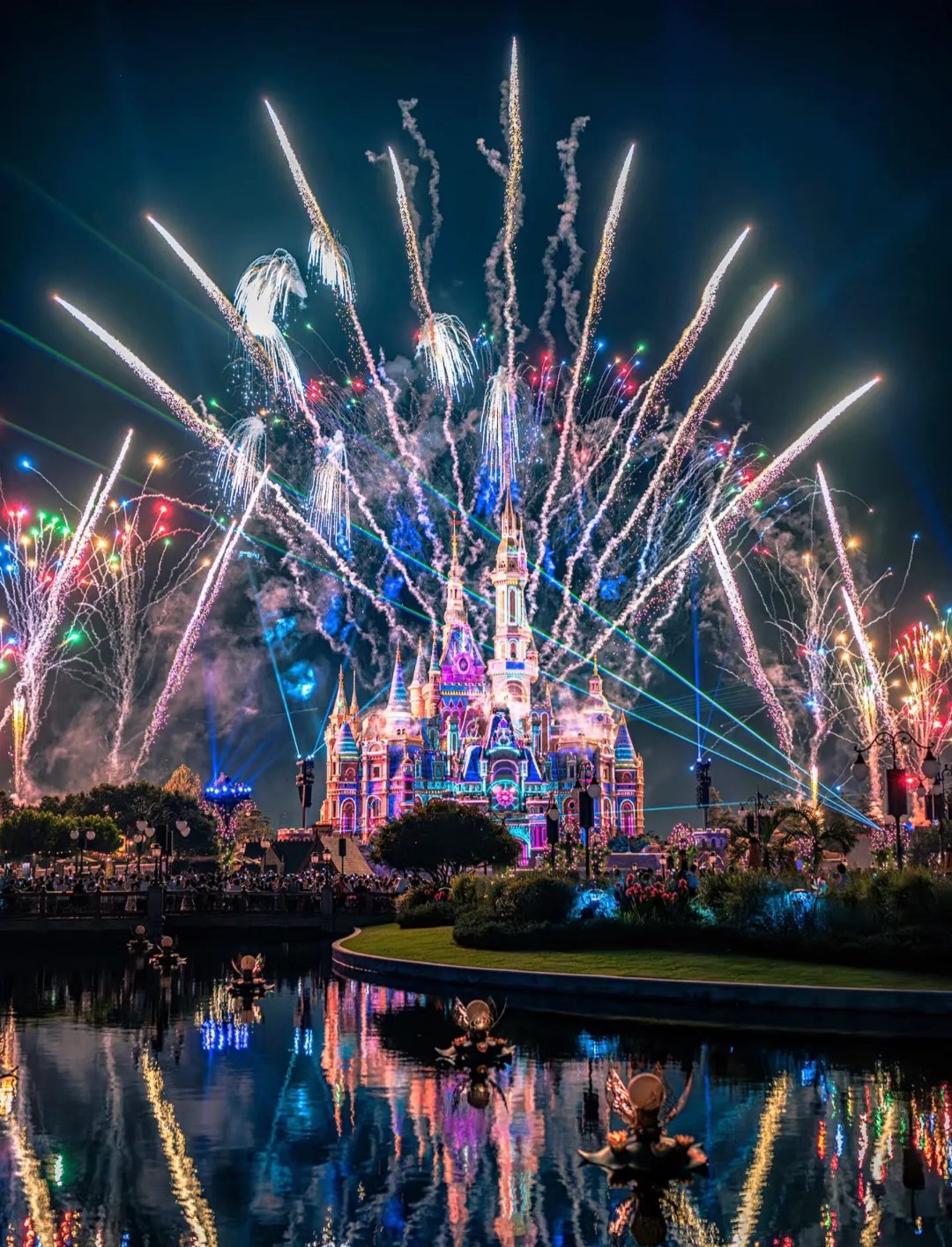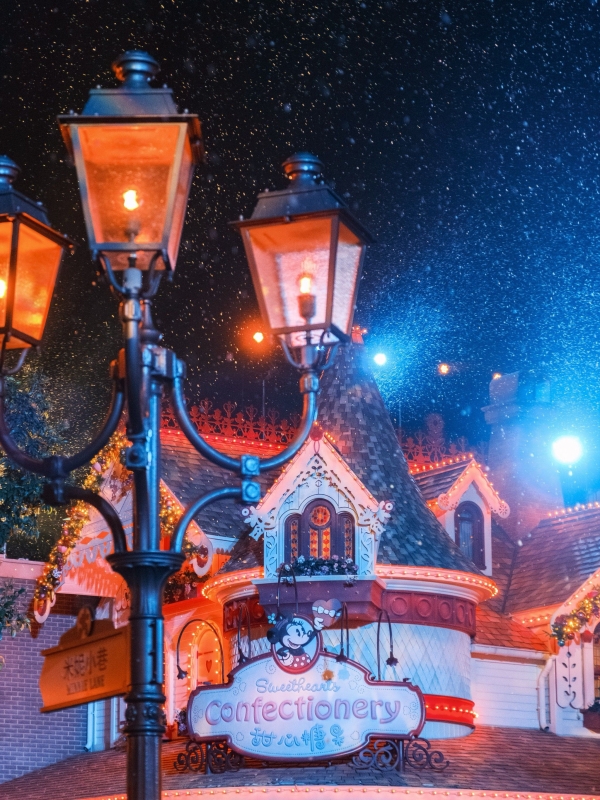Shanghai is often called China’s fashion capital, and the moment you set foot downtown it makes sense. From massive malls glowing over the skyline to noisy markets where vendors pull at your sleeve, the variety of Shanghai clothing stores is overwhelming. Every corner seems to hold a different layer of style: glass-walled luxury boutiques, fast fashion outlets changing stock weekly, and small tailor shops cutting fabric late into the night. It can feel exciting but also confusing for a first-time visitor. That’s why this guide pulls the streets, malls, and markets together into one map—so you know where to look, how much to spend, and what atmosphere to expect. Skip it, and you’d miss one of the most vivid parts of Shanghai’s everyday life.
Local Markets and Bargain Spots: Master the Bargain
- South Bund Fabric Market
- Tailor-made Suit
Qipu Road Market
Enter Qipu Road Market and the pandemonium comes fast. The hallways are crowded. Lights are harsh. The air reeks of sweat and fabric dye. Stalls occupy multiple floors, and each one teems with Shanghai clothing stores vying for the attention of passers-by. Sellers grab your arm and yell “cheap price, friend. Bargaining isn’t the failure of an empowered choice, it’s more like surviving. The selection is vast, from stylish jackets and jeans to dresses. I also encountered some spots that catered to niche categories, such as “Tao Yi Ku,” which had an enormous variety of vintage T-shirts; or “Chao Liu Qian Xian,” focused on seasonal women’s fashion. Shirts may typically start at ¥300, but with enough perseverance one can bargain them down to a mere ¥80. All the same, the quality varies wildly from stall to stall.
For visitors, patience and strategy are rewarded. Tourists gripe that fabrics fade after a wash. Still, discerning shoppers leave with complete outfits for the cost of one mall shirt. Come in the morning, when there are fewer people. Arrange to pay with cash or be prepared to use mobile payment. Don’t rush. Sure, Qipu is terrifying, but if you are willing to get dirty then beneath the piles of clothes lies some of the cheapest Shanghai clothes money can buy.
📍 Location: Hongkou District, Qipu Road Market
⏰ Hours: 9 AM – 6 PM
💰 Average cost: ¥80-300 per item after bargaining
🚇 Transport: Metro Line 10, Tiantong Road Station
💡 Tip: Go in the morning for fewer crowds and better deals.
South Bund Fabric Market
It doesn’t buzz with tour buses or bargain hunters like Qipu; here the real soundtrack is the steady whirr of sewing machines and the hiss of steaming irons. Walk through the three floors and you’ll quickly see why so many visitors come for suits. Stalls like Lao Jie Fabric & Garment Co. and Lao Shanghai Qipao Store stack walls of wool and cotton, ready to be cut to size. A measuring tape hangs loose on the tailor’s neck, and within minutes you’re being fitted. The price for a tailor-made suit is surprisingly low — usually ¥800 to ¥1,500 — and the turnaround is fast. Most shops deliver in just three or four days, far quicker than what you’d expect back home.
What makes it stand out is how easy the whole process feels. Tourists often walk in with nothing more than a phone photo of a style they like, and the tailor nods confidently before starting. English is spoken well enough for measurements and choices, and if you hesitate, fabric samples are pulled out for you to touch. One traveler I met couldn’t stop smiling when his suit was delivered to his hotel, pressed and ready for the evening. Paying a deposit is standard, and though fitting rooms are tight and hot, the final result makes you forget the wait.
Getting a suit here isn’t just about the low cost — it’s about the thrill of seeing something custom-made for you come together so quickly. Compared with buying off the rack in malls, this feels like a shortcut into Shanghai’s fashion world, where convenience and craftsmanship go hand in hand. Walking out with a perfectly cut suit, at a fraction of what you’d pay in the West, is the kind of travel win that lingers long after the trip.
📍 Location: Huangpu District, South Bund Fabric Market
⏰ Hours: 10 AM – 7 PM
💰 Average cost: ¥800-1500 for a custom suit
🚇 Transport: Metro Line 9, Xiaonanmen Station
💡 Tip: Bring photos of styles you like to show tailors.
AP Plaza (Yinyang Market)
AP Plaza is in the basement of the Science and Technology Museum metro station. Its corridors hum with sellers calling out from all sides. Renowned for copy goods, it’s also filled with Shanghai clothing stores hawking jackets, jeans, sneakers and dresses. Sellers are aggressive, even tailing customers in the aisles. But for many shoppers, the excitement of haggling brings them back. Unabashedly trendy stores abound, there’s Xiha Yi Lang for sporty chic and Jiao Xia Sheng Feng for shoes – just to name a few. A fake leather jacket may sell for ¥600. Some dogged bargaining can knock it down to ¥150.
Not everything and everyone is meant to be shopped for here. The underground air in summer can be clotted. The labyrinth of stalls can be disorienting. While alluring for the adventurous shopper, AP Plaza is a game of chasing bargains. You can come across somewhat peculiar fashion items that never see the light of day in glossy malls. If you go, take your time. Expect aggressive sales tactics. Think of it as an urban adventure rather than a leisurely shopping visit.
📍 Location: Pudong New Area, AP Plaza at Science & Technology Museum Station
⏰ Hours: 10 AM – 7 PM
💰 Average cost: ¥150-600 per item after bargaining
🚇 Transport: Metro Line 2, Science & Technology Museum Station
💡 Tip: Be patient, and always bargain with a smile.
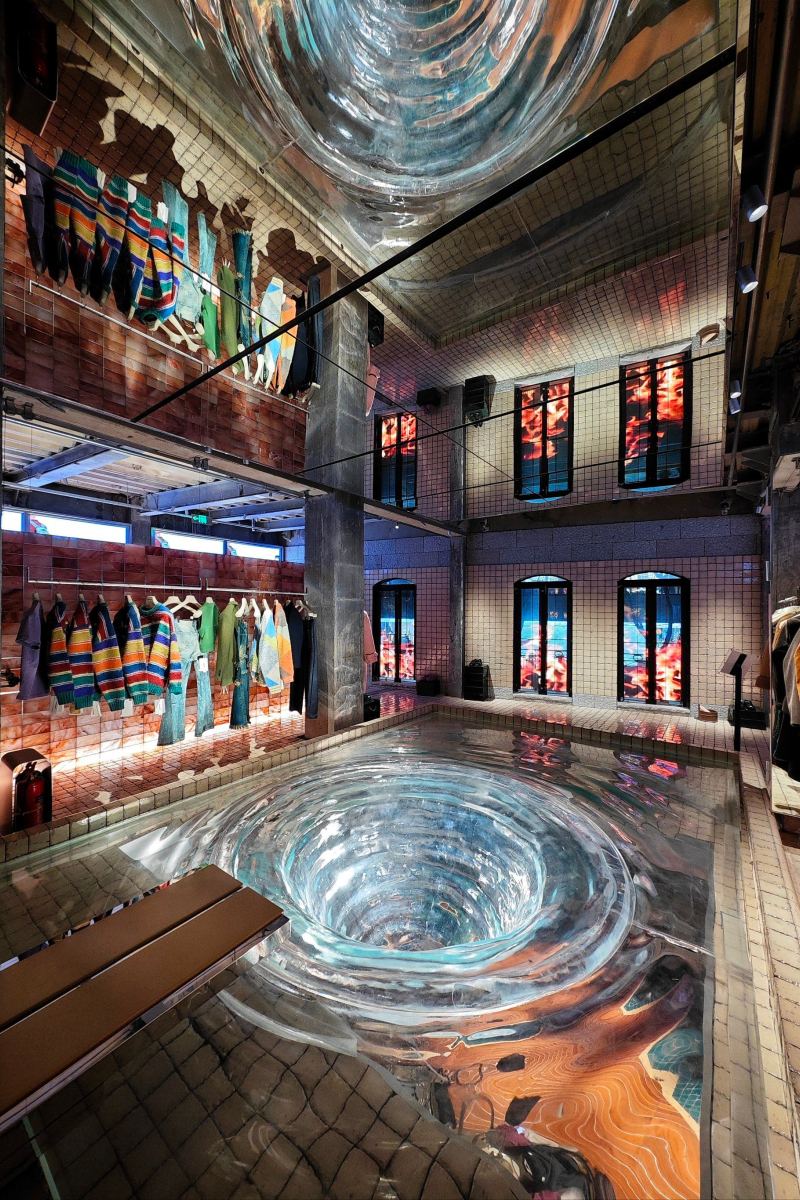
Huaihai Road
Nanjing Road Pedestrian Street
Nanjing Road is a colorful and noisy onslaught of sound. Neon signs glare back at shop windows. The air is warm and buzzing. It’s a street that never really sleeps, and the energy envelopes you the minute you enter. The variety of Shanghai clothing shops here is wide. Giant international chains like Uniqlo and Zara rub shoulders with older Chinese department stores, such as No. 1 Department Store and Shanghai Fashion Company. They’re crowded with shoppers from morning till night. Racks get turned over fast inside fast fashion stores. The department stores sell more formal brands that are also more expensive. Hiding in side alleys, small stores like Feiyue Concept Store offer something less mainstream if you care to look.
Prices swing widely. A basic T-shirt might run ¥200; a brand-name coat easily push up above ¥5000. The crowd can feel overwhelming. There’s music coming from LED billboards, which adds to the intensity. For first-time visitors, it’s best to divide the day. Explore the historic shops during daylight hours when it feels less chaotic. Then come back at night to see the street turn into a neon fashion show. It’s more than merely shopping; it involves a blend of culture, history and spectacle. And that’s what makes Nanjing Road unforgettable.
📍 Location: Huangpu District, Nanjing Road Pedestrian Street
⏰ Hours: 10 AM – 10 PM
💰 Average cost: ¥200-5000 per item
🚇 Transport: Metro Line 2, People’s Square Station
💡 Tip: Visit early morning for calmer crowds, or after 8 PM for neon views.
Huaihai Road
Huaihai Road gets the five-lane expressway, but it feels more sedate and polished than Nanjing Road. It feels cooler under the tall trees. Gallery-like: glass storefronts reflect the sunlight. It’s what a lot of visitors consider the fashionable face of Shanghai clothing stores. It is quieter but alive with footfalls and the distant purr of traffic. The blocks are lined with high-end brands like Louis Vuitton and Cartier. The Parkson Department Store and Maison Mode are the two anchors. Parkson also stocks an extensive range of international names, cosmetics and clothes over several floors making it feel like a department store as well. Right next door, Maison Mode takes more of a boutique approach — compiling seasonal pieces as well as material from imported designer brands. Shoppers drift between the two, browsing slowly, comparing styles. Mid-range names such as COS or Muji balance out the luxury-heavy cast.
Prices here are steep. Jackets begin at about ¥3000, and dresses can go considerably higher. Yet browsing feels like entertainment. Quiet music plays. Air conditioning was cooler to beat the heat of summer. The service is attentive but not pouncing. Sometimes flash sales appear. Locals wait quietly in line for a hope of a discount on their favorite brand. For first-time visitors, my advice is straightforward: Come prepared to drop some cash — or at least browse. Bring an internationally accepted card. Take time to savor the street and the quiet, genteel ambiance of Huaihai Road.
📍 Location: Huangpu District, Huaihai Middle Road
⏰ Hours: 10 AM – 10 PM
💰 Average cost: ¥800-3000+ per item
🚇 Transport: Metro Line 1, South Shaanxi Road Station
💡 Tip: Evenings are cooler and more relaxed for strolling.
West Nanjing Road
The mood changes again while walking down West Nanjing Road toward Jing’an Temple. The street seems busy but not quite as chaotic. Blocks are lined with glass towers shaded by office buildings. In the evenings, mall lights splash across sidewalks and produce a sheened glow. Gucci and Louis Vuitton set up shop at Plaza 66. Its marble halls are lined with luxury boutiques and statuesque shop assistants. A few blocks over, smaller malls are home to midrange brands and edgy streetwear shops. I once ducked inside a side shop that was nondescript from the outside but with full racks of indie Chinese labels such as SANKUANZ and everything priced 400-800 RMB. It is proof that treasures remain concealed.
The Shanghai dry-goods stores here present two very different aspects. Prices stretch from ¥300 streetwear T-shirts to coats costing thousands. The vast majority of stores are glad to receive international cards. It’s worth planning your route, for newcomers. Begin at Jing’an Temple for the feel. Scope out the luxury towers, if you have a budget that will stretch to it. Then head into the side alleys for boutiques. The mix of high-end and everyday options make West Nanjing Road one of the most well-balanced neighborhoods for shopping at Shanghai clothing stores.
📍 Location: Jing’an District, West Nanjing Road
⏰ Hours: 10 AM – 10 PM
💰 Average cost: ¥300-5000+ per item
🚇 Transport: Metro Line 2, Jing’an Temple Station
💡 Tip: Start from Jing’an Temple and walk east for the best mix of stores.
Wondering what to buy in Shanghai besides the latest outfits? Visit Best Things to Buy in Shanghai 2025: Top 10 Souvenir Picks
Iconic Shopping Malls: Indulge in High-End Brands
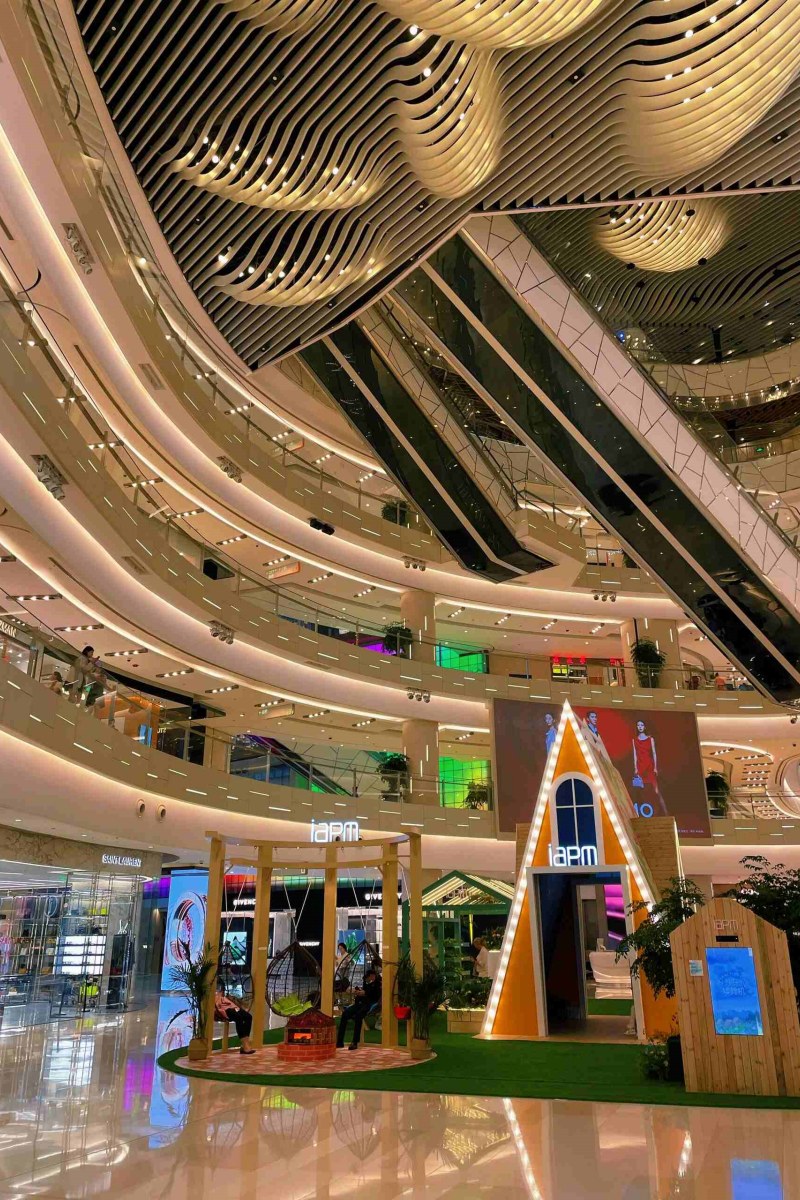
IAPM Mall
IFC Mall
Strolling into IFC Mall beneath the Oriental Pearl Tower is like stepping through the doors of a temple to luxury. The smell of perfume hangs in the air. Each floor corresponds to flagship stores of Chanel, Dior, Hermès and Prada. Shoppers shuffle slowly under harsh bright lights, scanning coats and dresses that cost well into the thousands. There’s even an Apple Store if you tire of fabrics. This is the spot for visitors in pursuit of prestige brands.
Practical details are simple. Expect coats around ¥10,000. Carry an internationally recognised credit card. Service here is polished and attentive if rarely pushy. It’s worth the stop if your budget permits. If not, window shopping will still whet your appetite for Shanghai’s upscale fashion culture.
📍 Location: Pudong New Area, Lujiazui, IFC Mall
⏰ Hours: 10 AM – 10 PM
💰 Average cost: ¥3000-10000+ per item
🚇 Transport: Metro Line 2, Lujiazui Station
💡 Tip: Window shopping is worthwhile even if you’re not buying.
IAPM Mall
IAPM Mall feels less intimidating. It’s a marriage of luxury and middle-of-the road favorites. There are high fashion boutiques including Givenchy and Balenciaga, as well as mass market chains like COS and Muji. These are stores catering to a younger local and out-of-town crowd looking for more affordable Shanghai-style clothing retailers. The huge atrium is lively. The basement smells of ramen and bubble tea. The mall is also down-to-earth and fashionable.
Prices run between ¥300-1500. Nearly all of the stores accept Visa or Mastercard. There’s a great little swimming hole in the summer. I always wind up compulsively buying something. Take your time wandering here. It’s a wide enough variety to suit different budgets, while at the same time not forgetting that you’re in the hippest part of town in Shanghai.
📍 Location: Xuhui District, Huaihai Middle Road, IAPM Mall
⏰ Hours: 10 AM – 10 PM
💰 Average cost: ¥300-1500 per item
🚇 Transport: Metro Line 1, South Shaanxi Road Station
💡 Tip: The basement food court is a great break between shops.
Joy City
Joy City is boisterous, whimsical and exuberant. Forget marble floors. Here you’ll find anime stores, sneaker boutiques like Nike Kicks Lounge and Adidas Originals, and Shanghai clothing shops that flip stock almost every week. On the roof, a lit-up Ferris wheel turns against the cityscape. Shoppers have an otherworldly view as bags pile at their feet.
Streetwear hoodies go for ¥200-400. Sneakers cost ¥600-1200. Patience is key. Root through the racks, and you may well find a gem at half the price found elsewhere. Joy City serves people hunting young trends. It’s chaos, but it’s also part of the fun for travelers who want something a bit more casual than polished luxury.
📍 Location: Jing’an District, Joy City Mall
⏰ Hours: 10 AM – 10 PM
💰 Average cost: ¥200-1200 per item
🚇 Transport: Metro Line 8, Qufu Road Station
💡 Tip: Don’t miss the rooftop Ferris wheel after sunset.
Creative Streets and Designer Boutiques: Explore Unique Style
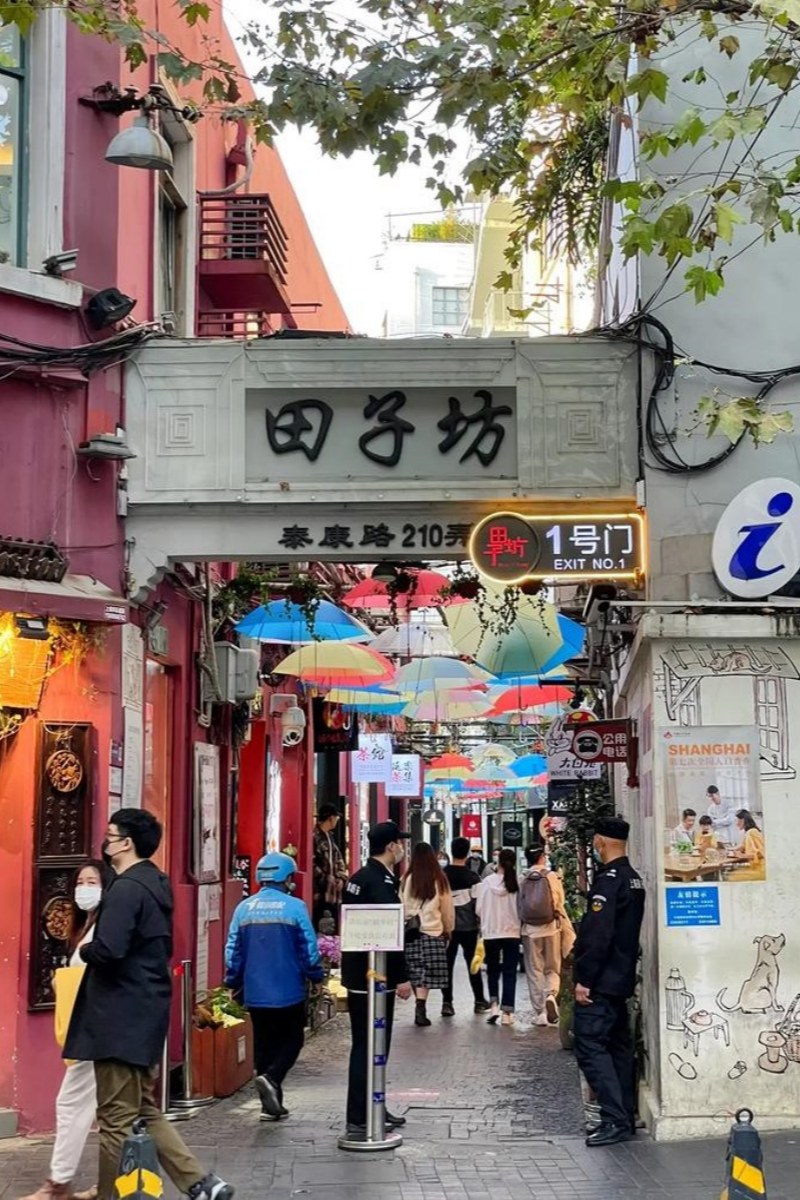
Tianzifang
Tianzifang
Entering Tianzifang is like going in to a maze of tight brick alleys. The walls are clothed with ivy. The air is scented with a hint of coffee and incense. Flickering neon signs hang above wooden doors. But here, Shanghai clothing stores become indie boutiques. They sell handmade jackets, linen dresses and quirky accessories. Shops such as “Liliang” with sophisticated silk items, or gem shop & hand-made jewelry/accessories bags specialty store “Ying Zhi Mei”, are lined in the streets. Expensive, the high end is a lot more expensive than Qipu, being around ¥500-1200. But everything, somehow, feels as if it has its own story behind it. You might even find the designer behind the counter, drinking tea and telling you about the cut of a dress or the fabric selection.
Tianzifang offers more than shopping. It’s a mix of conversation, exploration and cultural walk. By and large, most stores take mobile payments; cash is acceptable at smaller stands. Plan to spend much of an afternoon here, looking leisurely. Pop into the surrounding cafés when the alleys are crowded. If you’re seeking unusual Shanghai clothing stores this is a great place to discover pieces that are different.
📍 Location: Huangpu District, Tianzifang
⏰ Hours: 10 AM – 10 PM
💰 Average cost: ¥500-1200 per item
🚇 Transport: Metro Line 9, Dapuqiao Station
💡 Tip: Best visited on weekdays when alleys are less crowded.
Xintiandi
The area is intrinsically linked to the history of the fashion styles in China.” Xintiandi is a fusion of history and fashion in a lovingly restored setting. The shikumen houses that were saved lend the district a unique appearance. Sleek Shanghai clothing stores open through stone archways and narrow entrances. China’s own upscale proliferation, ICICLE and Comme Moi, fill the storefronts here, with imported brands like Tory Burch. It’s fashionable to walk around here at night, with warm lights reflecting off the old brick walls. It’s fun to browse here, even if you don’t buy.
Expect shirts from ¥800. Dresses can easily exceed ¥2000. Prices reflect the premium location. All along the streets are cafes and restaurants where you can sit down with your heavy bags. Credit cards are widely accepted. Staff — many of whom speak English — are friendly and helpful, making it easy for international visitors. Come, not only for shopping but to see how Shanghai mingles old architecture with new fashion.
📍 Location: Huangpu District, Xintiandi
⏰ Hours: 10 AM – 10 PM
💰 Average cost: ¥800-2000+ per item
🚇 Transport: Metro Line 10, Xintiandi Station
💡 Tip: Evenings are lively with cafés and restaurants open late.
French Concession Boutiques
The French Concession is quieter, shaded by plane trees and the sound of cicadas. And behind these streets are some of the most esteemed designer boutiques in town. There’s also a standout store for Uma Wang. Walking in is a little about entering a gallery. Standout stores include the bigger Dong Liang, which stocks a variety of up-and-coming Chinese designers, and smaller studios such as Ms.Lau that specializes in tailored bespoke items. The Shanghai clothing shops here are about workmanship and detail. Coats start at ¥3000+. The room is quiet, as opposed to the buzz of activity out on the streets.
My advice for visitors is to take it slow.” Explore side lanes. There are smaller boutiques mixed with cafés and studios. Most shops accept cards. Many staff speak basic English. But prices are steep, so plan your budget accordingly. For fashion-minded travelers, this district brings Shanghai creativity and chic in an elegant environment.
📍 Location: Xuhui District, French Concession
⏰ Hours: 11 AM – 9 PM
💰 Average cost: ¥3000+ per item
🚇 Transport: Metro Line 1, Hengshan Road Station
💡 Tip: Take time to explore side lanes for hidden boutiques.
Practical Shopping Tips: Know Before You Go
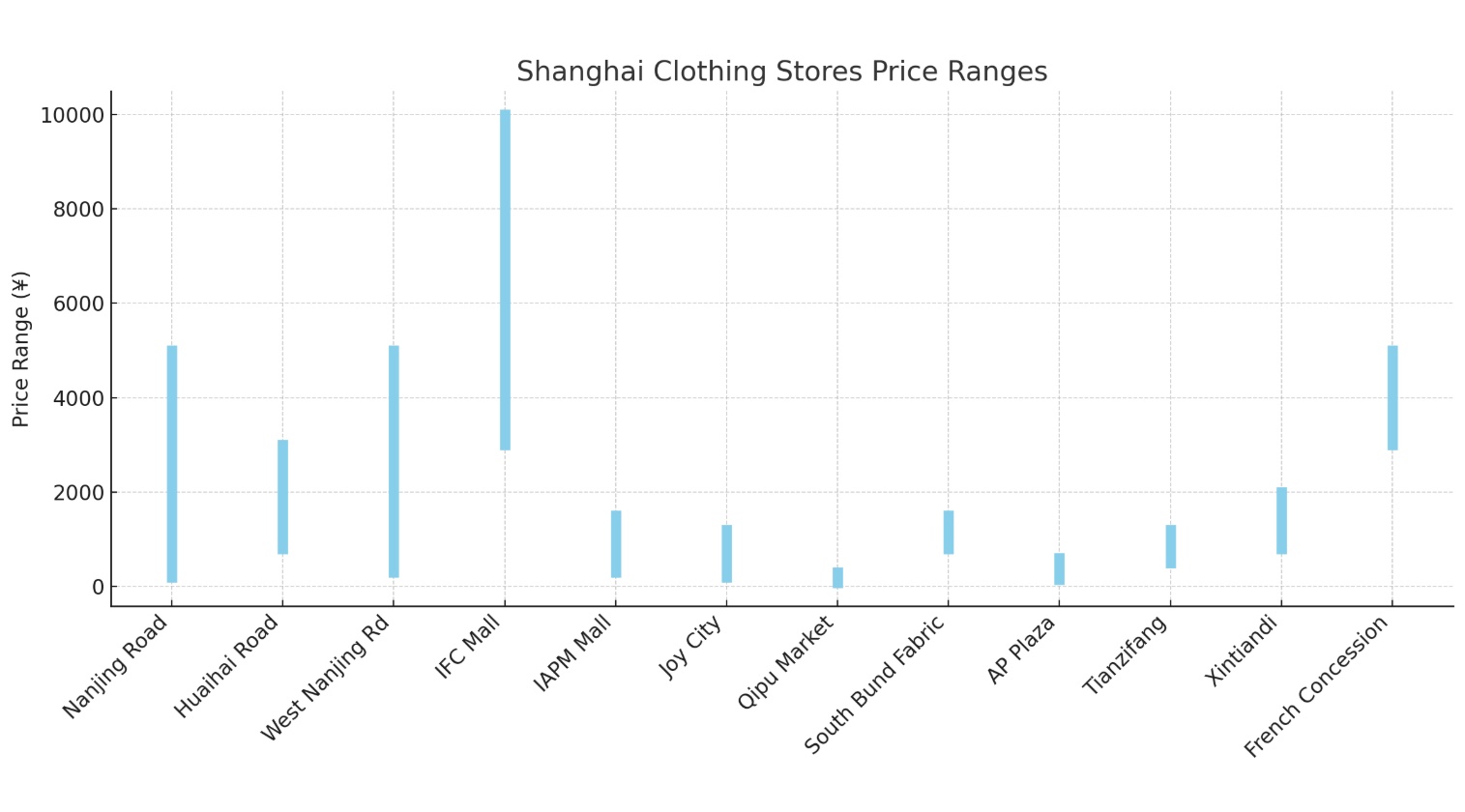
Price Range
Payment and VAT Refunds
Visa and Mastercard are generally accepted in malls. At markets, many Shanghai clothing stores accept Alipay or WeChat Pay. For travelers who do not carry a Chinese bank card, attaching an international card to these apps ahead of time can be a major convenience. If you have big-ticket items in mind, find out about VAT refunds. They should be there provided you spend more than ¥500 in a single shop and show your passport. Refund centers in airports are often crowded, so keep all receipts neatly folded and together. Show up well before your flight. One strategy is to buy from larger stores at malls where staff habitually process tax forms and can assist you.
Size and Fit Differences
Chinese size are generally smaller than the US size. A Chinese L might be equivalent to a European M. Always try before buying, and especially so in street markets where getting your money back may not even be an option. Some Shanghai clothing stores post side-by-side charts listing Asian and Western sizes. In the markets, it is frequently a matter of guesswork. A helpful hint is to purchase a size up and get it tailored by a local seamstress. Remedies are relatively cheap and easy. If you’re buying for someone else, take measurements (Franco Graziosi suggests neck and chest, in centimeters) instead of assuming that a letter size will be safe.
Bargaining and Etiquette
At Qipu or AP Plaza, bargaining is part of the culture. Stall owners expect it. Start low, perhaps at one-third of the asking price. Watch the seller’s reaction carefully. It helps to smile and stay lighthearted. Vendors often respect friendly persistence. Using your phone calculator to show your price is normal. A little Mandarin like “piányi yìdiǎn” (make it cheaper) can soften negotiations. In contrast, malls and boutiques operate with fixed pricing. Avoid haggling there. It only creates awkwardness. As a rule, treat bargaining like a game, and you’ll likely walk away with both a discount and a good story.
FAQ: Your Shopping Questions Answered
Q: Where can I find affordable Shanghai clothing stores?
A: Qipu Road Market is the hotspot. Clothes are cheap but quality varies. Bargain hard and check seams before buying. Many locals say mornings are better since stalls are fresher and less crowded, and you might even get a friendlier price if you linger around a bit longer. The building itself can feel hot and cramped in summer, and you may notice the smell of new fabric mixed with street food drifting in from outside, which adds to the raw atmosphere.
Q: Do Shanghai clothing stores accept international credit cards?
A: Big malls like IFC or IAPM usually accept them, but markets lean toward Alipay/WeChat. Cash still works in some places. I once saw a traveler try to swipe an Amex at Qipu with no luck, so it’s safer to bring a small stash of yuan just in case. Some boutique shops in Tianzifang also prefer mobile payments only, which can catch first‑timers off guard.
Q: Are sizes in Shanghai clothing stores different from the US or Europe?
A: Yes, they run smaller. Try before buying. A Chinese L often equals a Western M. Some shops even have conversion charts taped to the wall, though in markets it’s trial and error, so be ready for some surprises in the fitting rooms. A shop assistant once laughed kindly and handed me two sizes larger than I asked, saying “foreign size” with a smile.
Q: Can I get tax refunds when shopping in Shanghai clothing stores?
A: Yes, if you spend over ¥500 in one store and ask for a tax form. Refunds are collected at the airport. Staff at larger malls usually help with the paperwork, but lines at Pudong Airport counters can stretch long, so plan extra time before boarding. Some travelers mention refund counters at Hongqiao are less crowded, but the policies may vary.
Q: Is bargaining common in Shanghai clothing stores?
A: In markets, yes. In malls, no. Sellers expect you to haggle at Qipu or AP Plaza, not at Dior. Bargaining is almost a ritual there, and even showing a calculator with your counter offer works better than words sometimes. Some shoppers joke that the first price you hear is just a test of how confident you sound.
Q: Which area in Shanghai has the most luxury clothing stores?
A: Huaihai Road and West Nanjing Road are loaded with them—Gucci, LV, Chanel all line these streets. Walking through Plaza 66 feels like entering a museum of brands, while just across the road smaller boutiques add variety. Even the window displays here change seasonally, pulling crowds who only come to look.
Q: Where can I buy custom suits or qipao in Shanghai?
A: South Bund Fabric Market is best. Prices start around ¥800 and most tailors deliver within days. Tailors often ask for a deposit and may suggest fabrics you’ve never heard of, so bring a photo reference to avoid surprises. The fitting rooms are small and hot, but watching bolts of silk and wool being unrolled makes up for it.
Q: What time do Shanghai clothing stores usually close?
A: Malls close around 10pm, markets around 6‑7pm. Always check before heading out late. Some boutique shops in Tianzifang shut even earlier, especially on weekdays, leaving alleys unusually quiet. By contrast, Joy City stays busy into the night with its rooftop Ferris wheel still spinning.
Q: Are Shanghai clothing stores tourist‑friendly?
A: Malls and designer boutiques often have English‑speaking staff. Markets are noisier, but calculators and basic English are usually enough. A few stall owners even keep translation apps on their phones, so communication isn’t as impossible as it looks. Occasionally you’ll find handwritten signs in broken English like “Cheap suit good price,” which makes the interaction more charming than confusing.
Q: Is AP Plaza worth visiting for clothes?
A: Depends on your patience. Some enjoy the bargaining game, others find it stressful. Prices can be good if you don’t mind the pushy sellers. The underground setting feels stuffy in summer, but you might stumble on quirky fashion that never reaches the big malls. One visitor mentioned spotting limited‑edition sneakers here for a fraction of retail price, though authenticity is always a question.
